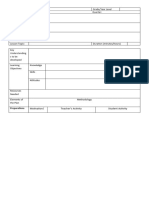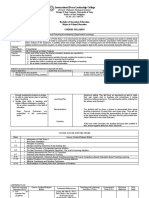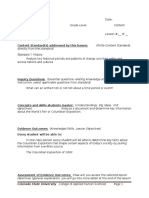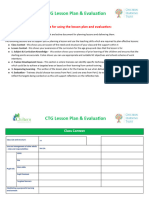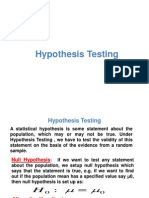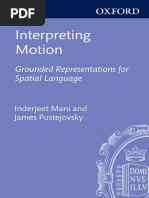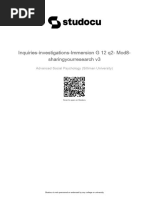Unit/Lesson Title Lesson Duration Stage Class
Unit/Lesson Title Lesson Duration Stage Class
Uploaded by
JackCopyright:
Available Formats
Unit/Lesson Title Lesson Duration Stage Class
Unit/Lesson Title Lesson Duration Stage Class
Uploaded by
JackOriginal Title
Copyright
Available Formats
Share this document
Did you find this document useful?
Is this content inappropriate?
Copyright:
Available Formats
Unit/Lesson Title Lesson Duration Stage Class
Unit/Lesson Title Lesson Duration Stage Class
Uploaded by
JackCopyright:
Available Formats
Unit/Lesson Title Lesson duration Stage Stage 2 or 3 Class
Unit/Topic title & Specific lesson title & Lesson Number in Time length of lesson Provide brief class description
sequence & include school context &
class composition
Lesson Objectives & Rationale Syllabus Outcomes Syllabus Content
What are the lesson objectives for this Specific syllabus outcomes from the Stage 2/3 K-10 Include the dot point content from the NSW BOSTES K-10
lesson (written in your own words)? NSW English syllabus 2012 English syllabus that you will be addressing in this lesson
Why am I teaching this lesson? What -copy and paste the outcomes here including the code. – the syllabus content within the specific syllabus outcomes for
skills and understandings of English am I this lesson that explicitly relate to your lesson content and the
targeting? outcomes:
-copy and paste the content here
-these should be targeted. Not broad.
Prior Knowledge Teaching and learning cycle Resources
What do the students already know, to What part of the teaching and learning cycle in What you will need in the class with you – USB with
enable them to participate fully in this lesson, English does this lesson correspond to? PPT, textbooks, worksheets, computer access, data
and to build on prior knowledge? projector, Smartboard, groupwork equipment
What previous key skills already acquired are (specify),student resources required (specify),…….
explicitly built on in this lesson?
Include prior knowledge for content learnt
already in this unit and, where appropriate,
understandings that might have been
developed before studying this unit.
Student Learning Time Guide Teaching Content & Student Learning Experiences Teaching Class Assessment
Indicators Approaches: Organisation Techniques
Precise indicators Write how many Grouping & What you use to
of intended student minutes you are Introduction (Engagement) Indicate: classroom assess learning
learning environment & how you
allowing for How will you immediately make an impact on the students * theoretical
each and make them keen to learn what you have to offer? perspectives and assess learning
Whole class, small
This is not the set step/part/activity models guiding your groups, pairs,
Be explicit about linking to previous lessons and previous Indicate when
of syllabus of the lesson. thinking individual work –
learning. Here you can set a context for the learning that and how you will
outcomes again, Indicate each *literacy strategies include how you
indicates the relevance of the lesson and what learning assess students
but very specifically time allocation *teaching will organise them to gather
must occur.
what students will at each step in strategies/methods. in any different
be learning and the lesson – so evidence of
Body (Exploration/Transformation/Presentation) groupings for student learning
doing at each step they align
of the lesson. across columns How the lesson progresses step-by-step – this records Indicate teaching different parts of –eg collecting
what is happening in the classroom so the outcomes you approaches, the lesson. responses and
It can be helpful to are addressing will be met and student assessment models/perspectives providing
list them in this activities are foregrounded in class activities. of English teaching Include any feedback,
way: “Students will employed at each features of marking
know/be able to…” Content (the “what happens?”), and Method (the “how step of the lesson so classroom responses,
with dot points does it happen?”) are both included here. This will be the they align across environment that observations,
following at each most extensive section. Indicate each step of the lesson - columns. are required – eg recording
stage/step of the transitions at each step in the lesson, activities at each displays, contributions,
lesson. step of the lesson – so they match across columns. Write rearranging methods of
questions to be asked and specific lesson instructions. spaces, student assessing
Indicate each Explain group and individual activity details and specific movement. student progress
learning and skill assessment activities to be completed. Include details of informally during
outcome at each how you will teach to diversity so that differentiation is not Indicate each the lesson, not
step in the lesson – an add on but built into the design of the lesson. This is organisation just formally at
so they align the ‘road map’ that another teacher could pick up and feature at each the end of the
across columns. teach without additional information, planning or step in the lesson unit (i.e.
resources. – so they align formative, not
In particular, this across columns just summative)
column should In your sequence of lesson activities, consider:
align very closely the sequence of learning activities that support For example,
with the students to develop the knowledge and skills responses to
assessment targeted (ie the outcomes) questions,
column the ways you allow students to see the checking work
connections between the learning activities and around the room,
the assessment activities to support their success quality of role
play, depth of
responses,
questions by
Conclusion (Presentation/Reflection) students, etc.
Conclude each lesson appropriately – drawing together
learning and assessment activities to allow students to Consider range
reflect on the learning achieved and to anticipate the and balance of
learning that will build on this lesson into the next lesson: assessment
this may involve a section of class time for student activities.
presentations, group work sharing, guided
question/response activities, etc. Ensure multiple
students need to be actively involved in the opportunities
conclusion of the lesson. throughout the
this section of the lesson may also involve lesson.
providing students with follow-up
questions/reflections/activities to build on their Attach
achievements in this lesson to introduce the next assessment
lesson. rubric/criteria to
indicate levels of
achievement.
Indicate each
assessment
activity/procedure
at each step in
the lesson – so
they align across
columns.
You might also like
- Robin Hood Case Questions Student-2Document4 pagesRobin Hood Case Questions Student-2iroeinrgre9302bNo ratings yet
- w2021 IplpDocument3 pagesw2021 Iplpapi-395010135No ratings yet
- Fs1 Episode 9 - 16 - Nadela, Ma - Mannyros PDocument61 pagesFs1 Episode 9 - 16 - Nadela, Ma - Mannyros PDaisel BodanioNo ratings yet
- Introduction From Fault Detection To Fault ToleranceDocument8 pagesIntroduction From Fault Detection To Fault ToleranceJavier LamedaNo ratings yet
- OB26a Teacher Reflection For Math LessonDocument2 pagesOB26a Teacher Reflection For Math Lessonsherdan genistonNo ratings yet
- Lesson Plan TemplateDocument4 pagesLesson Plan TemplateKevin Miscala CodillaNo ratings yet
- Instructional Plan (Iplan) Template: Motivation/Introductory ActivityDocument2 pagesInstructional Plan (Iplan) Template: Motivation/Introductory ActivitylehvrhonNo ratings yet
- Lesson Plan TemplateDocument3 pagesLesson Plan TemplateblominoqueNo ratings yet
- BLANK-IPLAN (Format)Document2 pagesBLANK-IPLAN (Format)That's Entertainment100% (1)
- Lesson Plan: I. PlanningDocument2 pagesLesson Plan: I. PlanningEricNo ratings yet
- I. Planning: Key Vocabulary: Function: FormDocument2 pagesI. Planning: Key Vocabulary: Function: FormEricNo ratings yet
- Lect2 (High Impact Teaching Strategies)Document9 pagesLect2 (High Impact Teaching Strategies)LUEL JAY VALMORESNo ratings yet
- Fundamentals of Curriculum Designing 20240228 210734 0000Document42 pagesFundamentals of Curriculum Designing 20240228 210734 0000xshiobhanNo ratings yet
- International Peace Leadership College: Bachelor of Secondary Education Major in Values Education Course SyllabusDocument6 pagesInternational Peace Leadership College: Bachelor of Secondary Education Major in Values Education Course SyllabusJosephine Aya100% (7)
- Charlyn Joy Abanas EDUC 109Document4 pagesCharlyn Joy Abanas EDUC 109Charlynjoy AbañasNo ratings yet
- observation Episode 8Document17 pagesobservation Episode 8Renz joseph CalimutanNo ratings yet
- Field Study 1 Learning Episode 8 Close Encounter With The School Curriculum Observe Analyze Reflect - CompressDocument11 pagesField Study 1 Learning Episode 8 Close Encounter With The School Curriculum Observe Analyze Reflect - CompressFransesca ReyesNo ratings yet
- Field Study 1 Learning Episode 8. Close Encounter With The School Curriculum Observe, Analyze, ReflectDocument11 pagesField Study 1 Learning Episode 8. Close Encounter With The School Curriculum Observe, Analyze, ReflectNica Elamparo Andales0% (1)
- ..Today Notes - 042714-1Document5 pages..Today Notes - 042714-1Joshua KiptooNo ratings yet
- Plan The Trainnig #KmmhasanDocument9 pagesPlan The Trainnig #KmmhasanKhan Mohammad Mahmud HasanNo ratings yet
- Middle School 3Document5 pagesMiddle School 3api-664134563No ratings yet
- College of St. John - Roxas: Flexible Learning Plan Course SyllabusDocument2 pagesCollege of St. John - Roxas: Flexible Learning Plan Course SyllabusMa. Thea Diane BillonesNo ratings yet
- StepplessonplanDocument9 pagesStepplessonplanapi-356930968No ratings yet
- English 301 Report OhahayyDocument7 pagesEnglish 301 Report Ohahayyklenthjhonmontil18No ratings yet
- Edu 412 Strategy Based Comprehension Lesson PlanDocument9 pagesEdu 412 Strategy Based Comprehension Lesson Planapi-667056132No ratings yet
- Pop Cycle CompleteDocument6 pagesPop Cycle Completeapi-700288110No ratings yet
- Community College of Manito Manito, Albay Poblacion, Manito, AlbayDocument6 pagesCommunity College of Manito Manito, Albay Poblacion, Manito, AlbayJuliet ArdalesNo ratings yet
- Mccue Pop CycleDocument9 pagesMccue Pop Cycleapi-701778924No ratings yet
- Chesmore Pop CycleDocument15 pagesChesmore Pop Cycleapi-701711466No ratings yet
- Edu 412 Disciplinary Literacy Lesson Segment TemplateDocument15 pagesEdu 412 Disciplinary Literacy Lesson Segment Templateapi-549570505No ratings yet
- PROF. ED. 6 The Andragogy of Learning Including PTM IDocument10 pagesPROF. ED. 6 The Andragogy of Learning Including PTM Ihoy poooNo ratings yet
- Module 3a Lesson 2 Ebonalo-2Document5 pagesModule 3a Lesson 2 Ebonalo-2florence s fernandezNo ratings yet
- FS1 - EP8 DoneeDocument9 pagesFS1 - EP8 DoneeDorado Lammy S.No ratings yet
- IG2 Scheme of Work (AY23-24)Document19 pagesIG2 Scheme of Work (AY23-24)harryshawvnNo ratings yet
- Ed 322 Writing Lesson Plan - Chelsea HeckmanDocument9 pagesEd 322 Writing Lesson Plan - Chelsea Heckmanapi-607580556100% (1)
- 3-26-24 Lesson Plan UgphDocument9 pages3-26-24 Lesson Plan Ugphapi-747341741No ratings yet
- Topic Lesson Plan On Course Plan, Master Plan, Unit PlanDocument29 pagesTopic Lesson Plan On Course Plan, Master Plan, Unit PlanAnas khan50% (2)
- Pelagio - Fs Module Lesson 2 4Document8 pagesPelagio - Fs Module Lesson 2 4api-613019400No ratings yet
- Lesson Plan English 02.25.23 PDFDocument74 pagesLesson Plan English 02.25.23 PDFAngel Mae BalangonNo ratings yet
- Strategy-Based Comprehension Math Words Problem - MergedDocument21 pagesStrategy-Based Comprehension Math Words Problem - Mergedapi-666837211No ratings yet
- Week 1 DLL - General MathematicsDocument5 pagesWeek 1 DLL - General Mathematicsanon_838476361100% (1)
- Star Observation Rubric: Department of EducationDocument2 pagesStar Observation Rubric: Department of EducationMary Jean Agudilla Caringal100% (6)
- Classroom Observation Tool COTDocument4 pagesClassroom Observation Tool COTRudy ClariñoNo ratings yet
- DLP INSTUCTION Copy 1Document4 pagesDLP INSTUCTION Copy 1Jennifer Dela FuenteNo ratings yet
- Instructional Practice Guide - ELA - 3-12Document6 pagesInstructional Practice Guide - ELA - 3-12CHRISTINE TAYAG100% (1)
- Lessonplan_startmiddleendDocument7 pagesLessonplan_startmiddleenddaimyvandijkNo ratings yet
- Field Study 1 Episode 8.1Document3 pagesField Study 1 Episode 8.1Marie Anjellyn AdolfoNo ratings yet
- Instructional Plan (Iplan) : Talugtug National High SchoolDocument10 pagesInstructional Plan (Iplan) : Talugtug National High SchoolGener Toledo100% (1)
- Edu 443 - Vocabulary Instruction Lp-MergedDocument7 pagesEdu 443 - Vocabulary Instruction Lp-Mergedapi-746878345No ratings yet
- Designing Strategy-Based Comprehension Instruction by Patrick Ramminger 1Document9 pagesDesigning Strategy-Based Comprehension Instruction by Patrick Ramminger 1api-668024321No ratings yet
- Lesson Plan - Math4 Subtraction SmashDocument8 pagesLesson Plan - Math4 Subtraction Smashapi-607580556No ratings yet
- Week 32 Y9 GargoyleDocument9 pagesWeek 32 Y9 Gargoylenatalieann1974No ratings yet
- Episode 8Document11 pagesEpisode 8annieguillermaNo ratings yet
- Professional Conversation Log 21 Simon Joachim 23-08-2021 1Document4 pagesProfessional Conversation Log 21 Simon Joachim 23-08-2021 1api-390078112No ratings yet
- Lesson 5.5 Pred 152 ReportingDocument20 pagesLesson 5.5 Pred 152 Reportingjbbandalan7No ratings yet
- High School 9-12 Reading Curriculum GuideDocument23 pagesHigh School 9-12 Reading Curriculum GuidemrsfoxNo ratings yet
- Pop Cycle Semester 1 Veronica DiazDocument10 pagesPop Cycle Semester 1 Veronica Diazapi-701046871No ratings yet
- RAISEPlus TemplateDocument1 pageRAISEPlus Templategelma furing lizalizaNo ratings yet
- Demo Teaching Guide Video Presentation of LPDocument5 pagesDemo Teaching Guide Video Presentation of LPLuci fireNo ratings yet
- Teacher Development Video ScriptDocument28 pagesTeacher Development Video ScriptKhanna MulberryNo ratings yet
- 2023 Student Teaching - Lesson Plan FormatDocument3 pages2023 Student Teaching - Lesson Plan FormatRaunak KumarNo ratings yet
- Academic Presenting and Presentations: Teacher's BookFrom EverandAcademic Presenting and Presentations: Teacher's BookRating: 5 out of 5 stars5/5 (1)
- Intro2 PDFDocument15 pagesIntro2 PDFxcvNo ratings yet
- The Neuroscience of Willpower 1Document7 pagesThe Neuroscience of Willpower 1api-488881256No ratings yet
- Hypothesis Testing MBADocument39 pagesHypothesis Testing MBAaksabhishek88No ratings yet
- Genograms and EcomapsDocument8 pagesGenograms and EcomapsDevan DaveNo ratings yet
- Individual Career Development Planning: A Survey: January 2014Document20 pagesIndividual Career Development Planning: A Survey: January 2014Jinky RegonayNo ratings yet
- Cambridge Business English - Four Skills Needs AnalysisDocument3 pagesCambridge Business English - Four Skills Needs AnalysisCharles ReiNo ratings yet
- An Examination of The Relationship Between Ability Model Emotional Intelligence and Leadership Practices of Organizational Leaders and EntrepreneursDocument251 pagesAn Examination of The Relationship Between Ability Model Emotional Intelligence and Leadership Practices of Organizational Leaders and Entrepreneursyav007No ratings yet
- Skripsi Riska Rahman PDFDocument130 pagesSkripsi Riska Rahman PDFGlo EstefaniNo ratings yet
- Malay Parents ConsiderationDocument24 pagesMalay Parents ConsiderationliongNo ratings yet
- Inderjeet Mani, James Pustejovsky - Interpreting Motion - Grounded Representations For Spatial Language-Oxford University Press (2012)Document177 pagesInderjeet Mani, James Pustejovsky - Interpreting Motion - Grounded Representations For Spatial Language-Oxford University Press (2012)Mina BožanićNo ratings yet
- Haddow 等 - 2022 - Survey of Low-Resource Machine TranslationDocument60 pagesHaddow 等 - 2022 - Survey of Low-Resource Machine Translationyedongyu1996No ratings yet
- Entrepreneurship: Articles Books & Chapters Cases Core Curriculum Course Modules - Simulations - VideoDocument16 pagesEntrepreneurship: Articles Books & Chapters Cases Core Curriculum Course Modules - Simulations - VideoKARTHIK145100% (4)
- What Is A Dissertation 1 PDFDocument8 pagesWhat Is A Dissertation 1 PDFzameerNo ratings yet
- Curriculum Planning and DesigningDocument5 pagesCurriculum Planning and DesigningMUTANO PHILLIMONNo ratings yet
- Lesson Plan Form: III/English IIIDocument6 pagesLesson Plan Form: III/English IIIapi-439274163100% (2)
- Ej 1152429Document20 pagesEj 1152429NURIN FAAIQAH BT MUSTAPHANo ratings yet
- CS2205 Ass 1Document3 pagesCS2205 Ass 1tanaka gwitiraNo ratings yet
- Analysis of Marketing Communication Tools and SalesDocument8 pagesAnalysis of Marketing Communication Tools and SalesAlexander DeckerNo ratings yet
- Schindel y Colombo 2014Document282 pagesSchindel y Colombo 2014martina eva garcia100% (1)
- How To Write Great Performance MeasuresDocument33 pagesHow To Write Great Performance MeasuresArturoNo ratings yet
- Persuasive Essay On School LunchesDocument3 pagesPersuasive Essay On School Lunchesafibxejjrfebwg100% (2)
- Inquires, investigation and Immersion moduleDocument26 pagesInquires, investigation and Immersion moduleCamille n cornelioNo ratings yet
- Activity Chart For Project: MID Term ExamDocument3 pagesActivity Chart For Project: MID Term ExamBe PoliteNo ratings yet
- DBU Outline of ThesisDocument2 pagesDBU Outline of Thesiswondwosen getachewNo ratings yet
- Exploring The Correlation Between Sleep Quality and Daily ProductivityDocument11 pagesExploring The Correlation Between Sleep Quality and Daily ProductivityMary Shaddeline ZafraNo ratings yet
- STA - 630 Mega Quiz File Solved by Binish Awais: EvaluationDocument42 pagesSTA - 630 Mega Quiz File Solved by Binish Awais: EvaluationFun NNo ratings yet
- 2021.methods To Discriminate Between Mechanism - Based Categories of Pain Experienced in The Musculoskeletal System - A Systematic ReviewDocument31 pages2021.methods To Discriminate Between Mechanism - Based Categories of Pain Experienced in The Musculoskeletal System - A Systematic Reviewm5yxyr4n4fNo ratings yet
- DOE DesignDocument22 pagesDOE DesignDobin HungNo ratings yet





